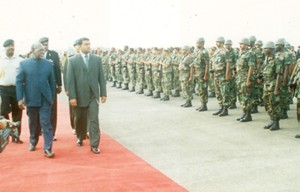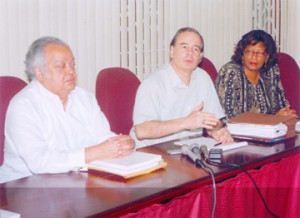With the ink barely dry on the historic maritime jurisdiction ruling by the United Nations Conference on the Law of the Sea (UNCLOS) Guyana and Suriname are at it again, this time, following the October 14, 2008 seixure by Suriname navel vessels of the Lady Chanrda, a privately –owned Guyanese boat on the Corentyne River.
In this issue the Guyana Review traces the recent prickly history of relations between the two CARICOM neighbours beginning with the Burnham/Pengel Agreement of more than forty years ago and concluding with the current state of relations between Georgetown and Paramaribo.
The interception and seizure of a Guyanese vessel − the Lady Chandra I − by Surinamese naval vessels on 14th October on the Corentyne River was only the most recent in a long history of hostile incidents by Suriname towards Guyana.
As so often in the past, the Surinamese Ministry of Foreign Affairs completely ignored Guyana’s protests against its forceful and unlawful action. Why have relations between the two neighbours been so distorted by muted but mutual hostility that makes the settlement even of minor incidents so difficult?
Forbes Burnham (1964-1985)
Guyana-Suriname relations had a cordial enough start with a visit by Prime Minister Forbes Burnham to Paramaribo even before Guyana’s independence in January 1966. Agreement was reached with Minister-President Johan Pengel on mechanisms for dealing with the territorial issue, functional co-operation in air, sea and road transport, and economic matters.

Warm relations quickly cooled. Tripartite talks in London in June 1966 among Guyana, The Netherlands and Suriname about the territorial controversy broke down and, as a result, no agreement demarcating the Guyana-Suriname border was reached. Coolness turned to controversy when the Guyana Police Force expelled a team of Surinamese surveyors from the New River zone in south-eastern Guyana in December 1967. This led to threatening and retaliatory behaviour by Suriname. Relations deteriorated, the Surinamese returning to the New River zone to construct a military fortification at a place it called ‘Tigri’. The Guyana Defence Force seized the camp in August 1969 to expel elements of the Surinamese Army. By this time, relations were in tatters.
It was a diplomatic achievement that negotiations between Prime Ministers Forbes Burnham and Jules Sedney led to a statement committing the two sides to the demilitarisation of the zone and the establishment of institutions to stimulate economic, social and cultural collaboration. But relations never really returned to normalcy and there was little progress even in functional co-operation. An example of the Suriname’s attitude to Guyanese was the
\incident in January 1985 when the Suriname Government expelled over 5,000 Guyanese (and Haitian) workers, on the pretext of ‘national security’.
Desmond Hoyte (1985-1992)
President Desmond Hoyte tried to revive inter-state relations with the re-activation of the Guyana-Suriname Cooperation Council in May 1986 but another three years would elapse before the inaugural meeting of the Council was held. A raft of other agreements including the Guyana-Suriname Anti-Narcotics Agreement signed in July 1989 had to wait five years for ratification but yielded no success in reducing that crime. Bilateral negotiations on fisheries cooperation were bogged down in Suriname’s insistence on exorbitant fees for licences for Guyanese fishermen operating in the Corentyne River and off the Atlantic Coast.

Suriname’s President Ramsaywak Shankar and Guyana’s President Desmond Hoyte, during the former’s visit to Guyana in 1989, agreed to establish National Border Commissions and the Guyana-Suriname Council aimed at improving cooperation in various sectors. They also discussed measures to activate a previously signed trade agreement. Later that year, President Hoyte paid an official return visit to Suriname and the two presidents agreed that a Suriname trade mission would visit Guyana.
Both presidents also agreed that, pending demarcation of the maritime boundary, authorities responsible for petroleum development in both countries should agree that the disputed maritime area could be jointly utilised. This agreement reached developed into the Memorandum of Understanding of 1991 that provided for the exploitation of petroleum resources in the “Area of Overlap,“ pending a resolution of the maritime border dispute. However, this agreement was never ratified by Suriname.
Cheddi Jagan (1992-1997)
President Cheddi Jagan’s post-October 1992 administration launched its foreign policy to Suriname by removing Guyana’s serving ambassador to Paramaribo and failing to appoint a replacement for the next two years. During President Cheddi Jagan’s state visit to Suriname in June 1994, the two sides agreed that meetings of the National Border Commissions and the Guyana-Suriname Cooperation Council would be ‘resuscitated’ but, in spite of several initiatives from Guyana, the meetings were not held.
The visit also resulted in a review of a range of areas of potential bilateral cooperation and an agreement to prepare a draft Extradition Treaty for the pursuit of escaping criminals. Formal agreement to cooperate in the development of bauxite, petroleum, hydro-power and gold resources also bore little fruit and cooperation in health and forestry encountered a similar lack of success. Promised agricultural cooperation in rice production yielded only a formal agreement.
If Dr Jagan had expected that his support for Suriname’s membership of the Caribbean Community would have softened Paramaribo’s stony attitude to Guyana, he was mistaken. Suriname formally tendered the Instruments of Accession to the Caribbean Community and Common Market on 4 July 1998 but its policy towards Guyana remained unchanged.
During his first visit to Guyana, President Ronald Venetiaan’s used the occasion of his address to the National Assembly, on Guyana’s Independence Anniversary — 26 May 1995, to express the seriousness with which Suriname viewed the border issue, saying that it “takes first place” in its relations with Guyana. His measured and deliberate statements on the issue explain his country’s intransigence and why talks so often reach a stalemate.
Samuel Hinds (1997)
During his nine-month tenure of office, President Samuel Hinds made no mark on Guyana-Suriname relations. A meeting of the Guyana-Suriname Co-operation Council took place in Georgetown during 30 April-1 May 1997 with Suriname frustrating progress by emphasising once again that improvement in bilateral relations hinged on the settlement of its territorial claim. The main contribution of Suriname’s Foreign Minister Faried Pierkhan, who headed his country’s 8-member delegation, was to remind his Guyanese hosts of his Government’s preoccupation with its territorial claim.
Not surprisingly, the functioning of the European Union-funded, Guyana-Suriname Ferry Project became paralysed by bureaucratic and procedural sloth spawned by Paramaribo although the ferry was formally launched in June 1997.
After thirty years of talking, therefore, legitimate trade between Guyana and Suriname declined while, largely through Guyanese ingenuity, the illegal smuggling of goods and narcotics across the Corentyne River soared. Guyana, meanwhile, gave the impression of having acquiesced in Suriname’s assertion of control over the Corentyne River by encouraging its fishermen to purchase fishing permits from the Suriname government.
Janet Jagan (1997-1999)
President Janet Jagan’s official visit to Suriname on 30-31 October 1998 took place at a time of internal instability in President Jules Wijdenbosch’s coalition administration. Since its election to office in May 1996, the Wijdenbosch Administration had been under pressure on both the domestic and external fronts resulting from the structural adjustment programme and from the disfavour of the Netherlands over an international arrest warrant for the former military ruler and leader of the senior coalition party in the Administration, Desi Bouterse, for narco-trafficking and money-laundering. It was not a propitious moment for international relations and, apart from the usual unimplementable agreements, nothing lasting was achieved.
Bharrat Jagdeo (1999-present)
By any measure, the nadir of Guyana-Suriname relations occurred during President Bharrat Jagdeo’s tenure of office. The Administration suffered an overwhelming diplomatic and military humiliation when, in June 2000, Surinamese gunboats evicted the Guyana-licensed, Canadian-operated CGX petroleum exploration platform from what is believed to be one of the region’s largest oil and natural gas fields. To add insult to injury, Paramaribo had deployed its naval vessels in the area in a show of strength, declared itself ‘the power in the river’ and led Georgetown on a meaningless diplomatic waltz which ended on 18 June, with the then Foreign Minister Clement Rohee conceding failure in his quest to restore the status quo ante. The next year, Mr Rohee was removed from the ministry.
The new Foreign Minister, Mr S. Rudolph Insanally, started to establish a framework for sustainable co-operation in a number of fields, including oil exploration. There was an initial flurry of activity. Suriname’s Foreign Minister Marie Levens paid a visit to Georgetown on 7-8 January 2002; Mr Insanally led a delegation to Suriname on 15-18 January and President Jagdeo himself visited that country on 28-29 January. Then, the familiar stasis set in.
The maritime problem remained unresolved until, acting under the United Nations Convention on the Law of the Sea, Guyana filed a petition to the Convention’s arbitration tribunal on 24 February 2004 to have the maritime border with Suriname delimited. The tribunal published its award delimiting the maritime zone on 20 September 2007, largely along the lines of Guyana’s claim.
Paramaribo protocols
Suriname’s seizure of the Lady Chandra I last October, therefore, should surprise no one in Takuba Lodge. It is entirely consistent with that country’s mean treatment of Guyanese nationals and its harassment and arrest of fishermen, seizure of their fishing vessels and imposition of heavy fines. Indeed, much of the diplomatic contact between Guyana and Suriname is about the latter’s frequent arrest, ill-treatment and imprisonment of Guyanese fishermen.
Little wonder that little gets achieved in bilateral relations between Guyana and Suriname. Every important issue that arises somehow is hinged to Surinamese assertion of sovereignty over the 15,000 km2 New River Zone, the entire Corentyne River and what used to be, until last year, the maritime overlap zone in the Atlantic Ocean.
Suriname’s single-minded pursuit of its national interest delayed the commencement of the Canawaima ferry project until every one of its demands was agreed to. Today, the vessel flies Suriname’s flag; offences committed on board are tried in Suriname’s courts; and the service seems to start and stop at Paramaribo’s beck.
Surinamese Ministers of the Government and officials seem to work under a diplomatic code that obstructs progress on functional co-operation projects by insisting on inserting spurious references to the territorial claims in their communiqués and minutes. Ordinary functionaries, travel agencies and other public and private groups earnestly offer token and gifts depicting maps showing the New River Zone as part of Suriname’s territory.
Unlike Suriname, Guyana has avoided establishing a permanent border commission made up of expert researchers and trained negotiators and backed by excellent language, archival and library resources. Guyana has been caught unawares, repeatedly, by Suriname’s very predictable behaviour. This country’s diplomatic efforts have been plagued by ad hocery, particularly the practice of cobbling together inadequately briefed border teams a few days before official visits and talks take place. The result is that those who ignore the errors of the past continue to repeat them.




